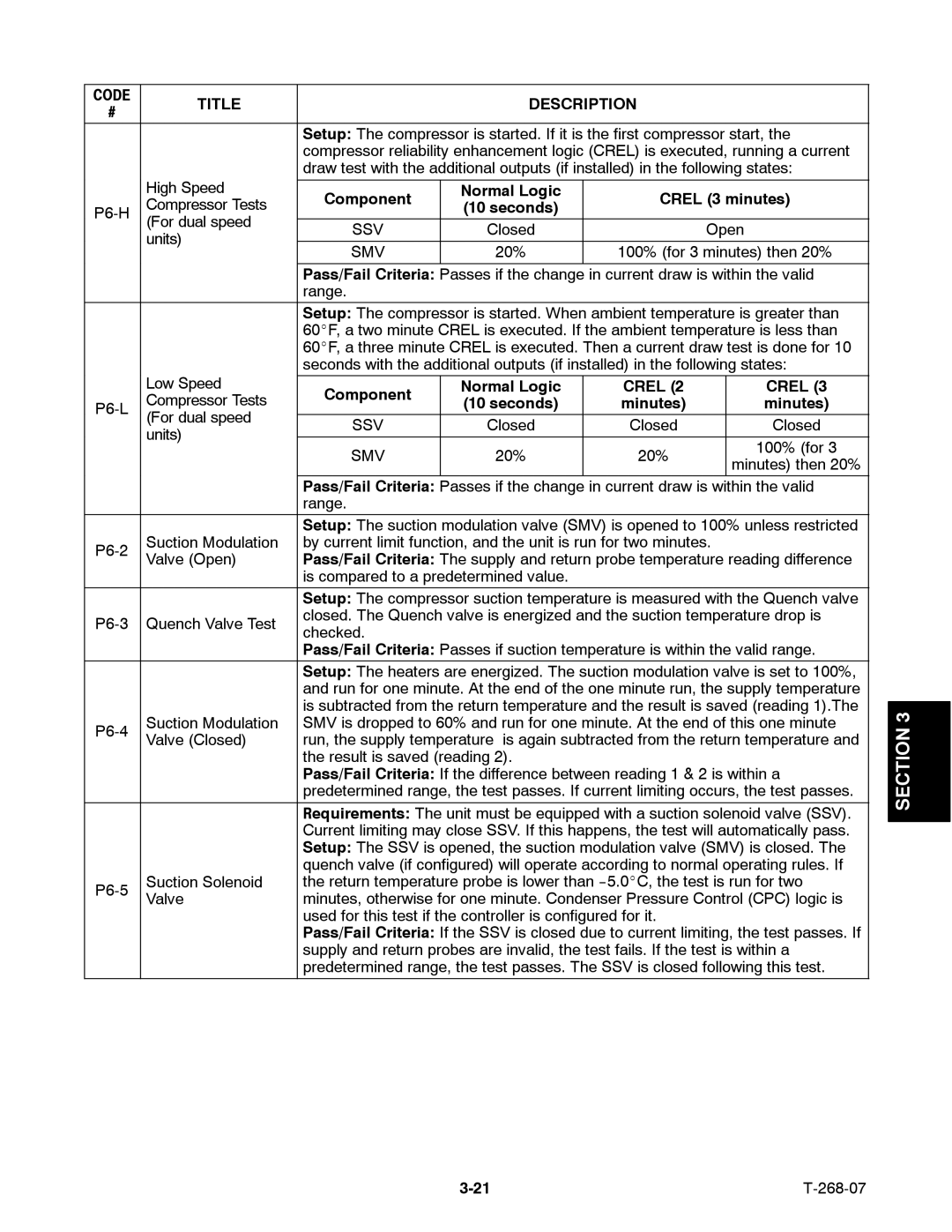CODE | TITLE |
| DESCRIPTION |
|
|
|
| |
# |
|
|
|
|
| |||
|
|
|
|
|
|
|
| |
|
| Setup: The compressor is started. If it is the first compressor start, the |
|
| ||||
|
| compressor reliability enhancement logic (CREL) is executed, running a current |
|
| ||||
|
| draw test with the additional outputs (if installed) in the following states: |
|
| ||||
| High Speed |
|
|
|
|
|
|
|
| Component | Normal Logic | CREL (3 minutes) |
|
| |||
Compressor Tests | (10 seconds) |
|
| |||||
|
|
|
|
|
| |||
(For dual speed |
|
|
|
|
|
|
| |
SSV | Closed |
| Open |
|
| |||
| units) |
|
|
| ||||
|
|
|
|
|
|
|
| |
| SMV | 20% | 100% (for 3 minutes) then 20% |
|
| |||
|
|
|
| |||||
|
|
|
|
|
|
|
| |
|
| Pass/Fail Criteria: Passes if the change in current draw is within the valid |
|
| ||||
|
| range. |
|
|
|
|
|
|
|
| Setup: The compressor is started. When ambient temperature is greater than |
|
| ||||
|
| 60_F, a two minute CREL is executed. If the ambient temperature is less than |
|
| ||||
|
| 60_F, a three minute CREL is executed. Then a current draw test is done for 10 |
|
| ||||
|
| seconds with the additional outputs (if installed) in the following states: |
|
| ||||
| Low Speed |
|
|
|
|
|
|
|
| Component | Normal Logic | CREL (2 |
| CREL (3 |
|
| |
Compressor Tests | (10 seconds) | minutes) |
| minutes) |
|
| ||
|
|
|
| |||||
(For dual speed |
|
|
|
|
|
|
| |
| SSV | Closed | Closed |
| Closed |
|
| |
| units) |
|
|
| ||||
|
|
|
|
|
|
|
| |
| SMV | 20% | 20% |
| 100% (for 3 |
|
| |
|
|
|
|
| ||||
|
|
| minutes) then 20% |
|
| |||
|
|
|
|
|
|
|
| |
|
| Pass/Fail Criteria: Passes if the change in current draw is within the valid |
|
| ||||
|
| range. |
|
|
|
|
|
|
|
| Setup: The suction modulation valve (SMV) is opened to 100% unless restricted |
|
| ||||
Suction Modulation | by current limit function, and the unit is run for two minutes. |
|
| |||||
Valve (Open) | Pass/Fail Criteria: The supply and return probe temperature reading difference |
|
| |||||
|
|
| ||||||
|
| is compared to a predetermined value. |
|
|
|
|
| |
|
| Setup: The compressor suction temperature is measured with the Quench valve |
|
| ||||
Quench Valve Test | closed. The Quench valve is energized and the suction temperature drop is |
|
| |||||
checked. |
|
|
|
|
|
| ||
|
|
|
|
|
|
|
| |
|
| Pass/Fail Criteria: Passes if suction temperature is within the valid range. |
|
| ||||
|
|
|
|
| ||||
|
| Setup: The heaters are energized. The suction modulation valve is set to 100%, |
|
| ||||
|
| and run for one minute. At the end of the one minute run, the supply temperature |
|
| ||||
|
| is subtracted from the return temperature and the result is saved (reading 1).The |
|
| ||||
|
| 3 | ||||||
Suction Modulation | SMV is dropped to 60% and run for one minute. At the end of this one minute |
| ||||||
| SECTION | |||||||
Valve (Closed) | run, the supply temperature is again subtracted from the return temperature and |
| ||||||
|
| |||||||
|
| the result is saved (reading 2). |
|
|
|
|
| |
|
| Pass/Fail Criteria: If the difference between reading 1 & 2 is within a |
|
| ||||
|
| predetermined range, the test passes. If current limiting occurs, the test passes. |
|
| ||||
|
|
|
|
| ||||
|
| Requirements: The unit must be equipped with a suction solenoid valve (SSV). |
|
| ||||
|
| Current limiting may close SSV. If this happens, the test will automatically pass. |
|
| ||||
|
| Setup: The SSV is opened, the suction modulation valve (SMV) is closed. The |
|
| ||||
|
| quench valve (if configured) will operate according to normal operating rules. If |
|
| ||||
Suction Solenoid | the return temperature probe is lower than |
|
| |||||
Valve | minutes, otherwise for one minute. Condenser Pressure Control (CPC) logic is |
|
| |||||
|
|
| ||||||
|
| used for this test if the controller is configured for it. |
|
|
|
| ||
|
| Pass/Fail Criteria: If the SSV is closed due to current limiting, the test passes. If |
|
| ||||
|
| supply and return probes are invalid, the test fails. If the test is within a |
|
| ||||
|
| predetermined range, the test passes. The SSV is closed following this test. |
|
| ||||
Page 59
Image 59
